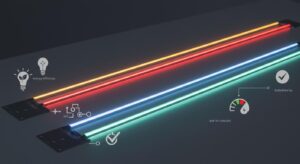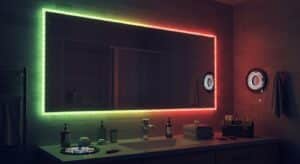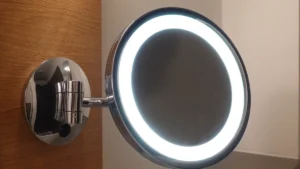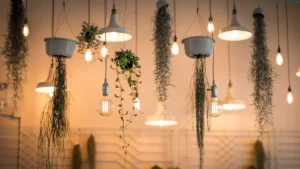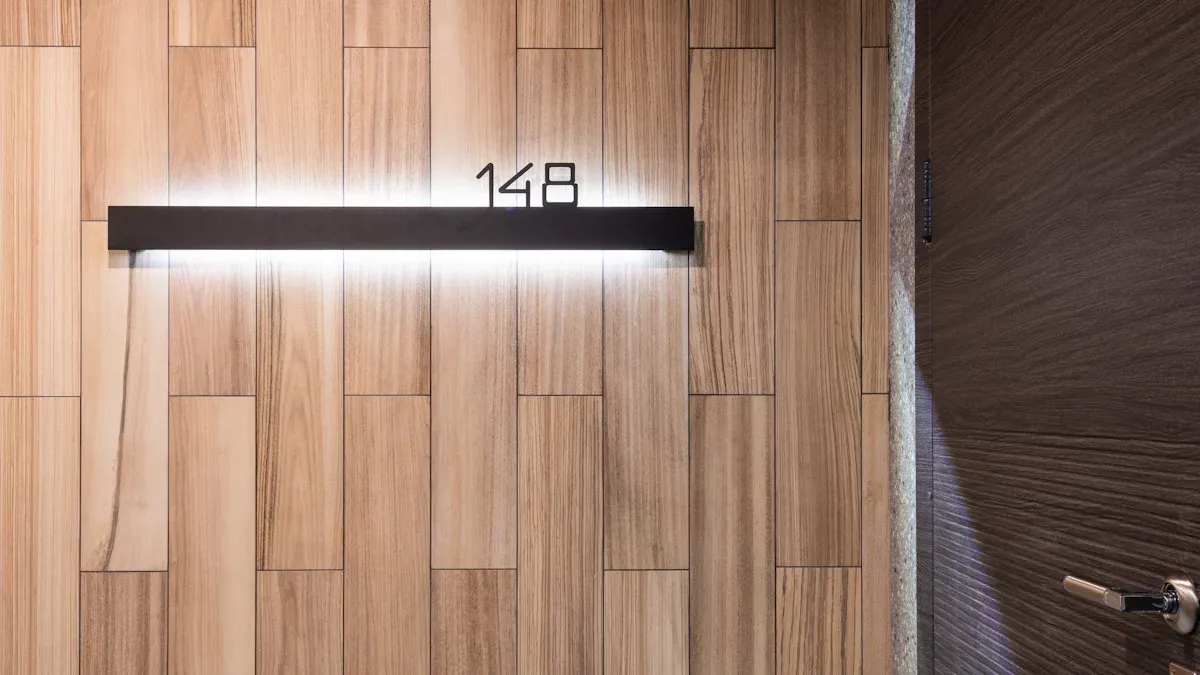
When selecting a COB LED Strip Waterproof, understanding IP65, IP67, and IP68 ratings is essential. These ratings indicate the level of protection against dust and water. Each rating is suited to specific environments. For instance:
IP65 resists water jets but is not suitable for submersion.
IP67 can be submerged in water for up to 10 minutes.
IP68 is completely waterproof and can remain underwater up to 3 metres.
Opting for the appropriate IP rating ensures durability and longevity. Outdoor or demanding areas require higher levels of protection to withstand harsh conditions. This decision significantly impacts performance and lifespan, particularly in challenging situations.
Key Takeaways
Learn about IP ratings: IP65, IP67, and IP68 show how well COB LED strips block dust and water. Pick the right one for your space.
IP65 strips work best indoors. They handle splashes but not being underwater. Use them in kitchens or bathrooms.
IP67 strips survive short underwater dips. They are good for outdoor places like gardens or patios.
IP68 strips give the most protection. They stay waterproof up to 3 metres deep. Use them for pools, fountains, or boats.
Choosing the right IP rating saves money. It also helps your COB LED strip last longer and work better where you need it.
Understanding COB LED Strip Waterproof Ratings

What IP Ratings Mean
IP ratings show how well a device is protected. They tell you how safe it is from dust and water. These ratings have two numbers. The first number shows protection from dust. The second number shows how much water it can handle. For example, IP65 stops dust and water jets, while IP68 is fully waterproof for long underwater use.
Knowing these ratings helps you pick the right strip. Whether it’s for indoor, outdoor, or underwater use, the IP rating ensures it lasts and works well in its environment.
How IP Ratings Indicate Waterproofing Levels
Different IP ratings mean different waterproof levels. Here’s what they offer:
IP65: Blocks water jets but cannot go underwater.
IP67: Can go underwater for 10 minutes but not longer.
IP68: Made for staying underwater up to 3 metres.
The table below explains these waterproof levels:
IP Rating | Description | Waterproofing Level |
|---|---|---|
IP65 | Stops water jets from all sides | Not for underwater use |
IP67 | Handles short underwater use (10 mins) | Water resistant, not for long submersion |
IP68 | Safe for long underwater use (3 m) | Fully waterproof |
This guide helps you choose the best COB LED Strip Waterproof for your needs.
Importance of IP Ratings for COB LED Strips
IP ratings are key to how long and well COB LED strips work. Without the right rating, water or dust can damage the strip. For example, IP65 works in kitchens or bathrooms with water splashes. But outdoor or underwater areas need IP67 or IP68 for better performance.
By learning about IP ratings, you can avoid wasting money on replacements. You can also make sure your COB LED Strip Waterproof fits its job. This knowledge helps you keep it safe and working efficiently.
IP65 COB LED Strips
Features of IP65
IP65 COB LED strips work well in places with dust or water splashes. They have an IP65 waterproof rating, making them good for indoor and outdoor use. These strips come in 110V or 220V options, fitting electrical systems worldwide. Their flexible design makes them easy to install, even in small spaces. They light up instantly with plug-and-play setup, so no waiting is needed.
Test Type | Description |
|---|---|
Electrical Performance Test | Checks power use, current, and energy against design standards. |
Luminous Efficiency Test | Measures brightness, colour, and efficiency using special tools. |
Environmental Adaptability Test | Tests weather resistance and waterproof ability in different conditions. |
Lifetime Test | Examines ageing and lifespan through fast life tests. |
Mechanical Performance Test | Tests waterproof levels with water sprays or immersion for IP65 and IP67. |
Benefits of IP65
IP65 COB LED strips have many advantages for different uses. They are strong and last longer because they have no solder joints. With up to 160 lumens per watt and a wide 180-degree light angle, they give bright and even lighting. They save energy by using less power while giving more light. Their anti-static feature helps them last longer, making them a smart choice. Their flexibility lets you use them in creative designs or tight spaces.
Metric | Description |
|---|---|
Enhanced Durability | No solder joints, stronger and less likely to break. |
High Luminous Efficacy | Bright light with up to 160 lumens per watt and wide light angle. |
High Efficiency | Uses less power while giving more light. |
Stronger Anti-static Capability | Resists static damage, helping it last longer. |
Uniform Lighting | Gives smooth light without visible LED dots. |
Flexibility | Fits creative designs and small spaces easily. |
Limitations of IP65
IP65 COB LED strips are useful but have some limits. The IP65 rating stops dust and water jets but doesn’t work in wet or underwater places. For areas like pools or underwater setups, choose IP67 or IP68 strips. Also, harsh weather over time can lower their performance.
IP65 isn’t made for full water protection.
Use IP67 or IP68 for wet or underwater areas.
Note: Picking the right IP rating helps your COB LED Strip Waterproof last longer and work better in its environment.
IP67 COB LED Strips
Features of IP67
IP67 COB LED strips are built to block dust and water. The first number in the rating means it is fully dustproof. The second number shows it can handle being underwater for 30 minutes at 1 metre deep. These strips have a strong silicone layer that protects them from damage. They are bendable, so you can use them in many places, even outside where it rains.
Feature | Description |
|---|---|
Dustproof Design | Keeps all dust out of the strip. |
Waterproof Capability | Works underwater for 30 minutes at 1 metre. |
Silicone Coating | Strong layer protects from weather and wear. |
Flexible Installation | Easy to use in outdoor or tricky spaces. |
Benefits of IP67
IP67 COB LED strips work well in tough conditions. Their waterproof rating makes them great for outdoor spaces like gardens or patios. The silicone layer keeps them strong and safe from damage. They give smooth, even light without showing LED dots. These strips save energy while staying bright. You can trust them in places with some water exposure.
Reliable Outdoor Use: Great for patios, gardens, or damp spots.
Durable Design: Silicone layer stops damage from wear and tear.
Uniform Lighting: Smooth light with no visible LED dots.
Energy Efficiency: Bright light but uses less electricity.
Tip: Pick IP67 COB LED strips for areas with occasional water contact.
Limitations of IP67
IP67 COB LED strips are not made for long underwater use. They can only handle short dips, so don’t use them in pools or fountains. Harsh weather over time might lower how well they work. If you need strips for constant underwater use, go for IP68-rated ones.
Not for Prolonged Submersion: Don’t use in pools or fountains.
Weather Sensitivity: Bad weather can affect how they perform.
Note: Picking the right IP rating helps your COB LED Strip Waterproof last longer and work better in its environment.
IP68 COB LED Strips
Features of IP68
IP68 COB LED strips give the best protection from dust and water. They are strong and work well in tough places. These strips keep out all dust and can stay underwater for a long time without breaking. Waterproof materials like silicone, glue, or epoxy resin stop water from getting in. Careful sealing and packaging make them even more waterproof. Many IP68 COB LED strips meet global standards like CE, ROHS, and UL, proving they are safe and reliable.
IP68 Rating: Fully dustproof and works underwater for long periods.
Waterproof Materials: Silicone, glue, or epoxy resin block water damage.
Packaging Technology: Tight sealing improves water resistance.
Standards Compliance: Certified by CE, ROHS, and UL for safety.
Benefits of IP68
IP68 COB LED strips are very strong and useful. They can handle being underwater, making them great for pools, aquariums, and fountains. You can also use them outside in gardens, patios, or business places like cafes and restaurants. They are perfect for ships and yachts, as they resist tough sea conditions. Their dustproof design keeps them working well in dusty areas too.
IP Rating | Dust Protection | Water Resistance | Suitable for Immersion |
|---|---|---|---|
IP68 | Full | Immersion | Yes |
IP67 | Full | Limited | No |
IP65 | Full | Water jets | No |
IP54 | Lower | Splash-proof | No |
Outdoor Lighting: Great for patios, gardens, and business spaces.
Underwater Use: Works well in pools, aquariums, and fountains.
Marine Applications: Ideal for ships and yachts, handling tough conditions.
Dusty Environments: Performs well in places with lots of dust.
Limitations of IP68
Even though IP68 COB LED strips are highly waterproof, they have some downsides. They cost more because of their advanced design and materials. Installing them can be harder due to extra protective layers. Over time, strong underwater pressure or harsh chemicals might shorten their life.
Higher Cost: Better materials make them more expensive.
Complex Installation: Extra layers need careful setup.
Pressure Sensitivity: Long exposure to deep water may reduce lifespan.
Tip: Use IP68 COB LED strips where top waterproofing and strength are needed.
Comparing IP65, IP67, and IP68 COB LED Strips
Differences Between IP65, IP67, and IP68
Knowing how IP65, IP67, and IP68 differ helps you choose wisely. Each rating shows a unique level of protection from water and dust.
IP65: These strips block water splashes and jets but can’t handle being underwater or in heavy rain. They work well in kitchens or bathrooms with some humidity.
IP67: These strips can go underwater briefly, making them good for outdoor areas with heavy rain or light water contact. They are not for long underwater use.
IP68: These strips are the most waterproof. They can stay underwater for a long time, making them great for pools or fountains.
The table below shows their technical differences:
IP Rating | Description | Protection Level |
|---|---|---|
IP65 | Stops low-pressure water jets from all sides. Covered with clear silicone. | Low water resistance |
IP67 | Handles short underwater use (15 cm to 1 m). Fully sealed with silicone and glue. | Short immersion protection |
IP68 | Works underwater for long periods (over 1 m). Fully sealed with strong silicone and glue. | Long immersion protection |
Similarities Across IP Ratings
Even with differences, IP65, IP67, and IP68 COB LED strips share some features. They all protect well against dust, keeping them working in dusty places. They also give bright light, over 160 lumens per watt, saving energy while lighting up spaces.
The table below shows shared features:
Metric | Description |
|---|---|
Efficacy | Over 160 lm/W, meaning bright and efficient lighting. |
Colour Rendering Index (CRI) | Between 70 and 90, showing colours clearly and accurately. |
Thermal Resistance | Good heat control means smaller heatsinks and longer life. |
These shared features make COB LED strips useful for many places, indoors, outdoors, or underwater.
Summary of Features and Applications
IP65, IP67, and IP68 COB LED strips are made for different places but still perform well. IP65 strips are best for indoor areas like kitchens or bathrooms with some water splashes. IP67 strips are better for outdoor spots like gardens or patios, handling heavy rain. IP68 strips are perfect for underwater uses like pools, fountains, or even on boats.
The table below sums up their uses and features:
IP Rating | Suitable Environment | Key Features |
|---|---|---|
IP65 | Indoor (humid places) | Resists water jets, easy to install |
IP67 | Outdoor (heavy rain) | Short underwater use, strong silicone cover |
IP68 | Underwater (pools, fountains) | Long underwater use, tightly sealed |
By learning about these ratings, you can pick the right COB LED Strip Waterproof for your project. This ensures it works well and lasts long.
Choosing the Right COB LED Strip Waterproof Rating
Best IP Rating for Indoor Use
When picking a COB LED strip for indoors, think about moisture and dust. For most indoor spaces, IP65 is good enough. These strips handle water splashes and dust well, making them great for kitchens, bathrooms, or living rooms. They work reliably without needing extra waterproofing.
IP65: Handles splashes, perfect near sinks or counters.
IP67: Protects against short dips in water, useful for saunas or indoor pools.
IP68: Fully waterproof but not needed for regular indoor spaces.
For most indoor uses, IP65 strips are affordable and effective. They last long without being overdesigned for rare indoor conditions.
Tip: Choose IP65 COB LED strips for most indoor areas unless there’s heavy moisture or dust.
Best IP Rating for Outdoor Use
Outdoor areas face tougher conditions like rain, dust, and temperature changes. IP67 strips are usually the best for these places. They block dust and handle short water dips, making them ideal for patios, gardens, and outdoor setups.
IP65: Works in covered outdoor spots with little water exposure.
IP67: Great for open spaces, handling heavy rain and water splashes.
IP68: Best for places with long water exposure, like ponds or fountains.
IP67 strips are practical for most outdoor lighting. Their sealed design and silicone layer keep them working in bad weather.
Note: Use IP67 COB LED strips for outdoor areas with heavy rain or water contact.
Best IP Rating for Underwater Use
Underwater setups need the highest waterproofing. IP68 COB LED strips are made for this. They block all dust and stay underwater up to 3 metres deep. This makes them perfect for pools, aquariums, and fountains.
IP Rating | Description |
|---|---|
IP20 | Not waterproof. Only for dry indoor places. |
IP65 | Blocks dust and splashes. Good for some outdoor spots. |
IP67 | Dustproof and handles short water dips. |
IP68 | Fully waterproof. Best for underwater use. |
IP68 strips use strong materials like silicone and epoxy to stop water. They are built to last, even underwater.
IP68 Waterproof Rating: Perfect for pools, fountains, and underwater setups.
Durability: Handles water pressure and stays strong underwater.
Tip: Always pick IP68 COB LED strips for underwater projects to ensure they last and stay safe.
Picking the right COB LED strip means knowing the IP65, IP67, and IP68 ratings. IP65 strips block dust and water sprays, making them good for indoors. IP67 strips can go underwater briefly, so they work well outside in rain. IP68 strips are fully waterproof, making them great for underwater use.
Tip: Choose the right IP rating for your space. Use IP65 in kitchens or bathrooms. Pick IP67 for gardens or patios. Go with IP68 for pools or fountains. This keeps the strip strong and working well.
Matching the IP rating to your needs saves money and reduces repairs.
FAQ
What does “COB” mean in COB LED strips?
COB means “Chip on Board”. It’s a way of putting many LED chips together on one base. This design gives smooth light without dots, making it great for places needing even lighting.
Can you cut COB LED strips to fit specific lengths?
Yes, COB LED strips can be cut at marked spots. These marks show where cutting won’t harm the strip. Always check the maker’s instructions to keep the strip working and waterproof.
How do you install waterproof COB LED strips?
Waterproof COB LED strips have sticky backs for easy setup. For outside or underwater use, add waterproof clips or holders. Seal all joins with waterproof connectors or silicone to keep the IP rating safe.
Are IP68 COB LED strips safe for saltwater environments?
Yes, IP68 COB LED strips work well in saltwater places. They are strong and resist damage, making them good for boats, yachts, or saltwater pools.
How do you maintain COB LED strips for long-term use?
To keep COB LED strips working, clean them with a soft cloth. Don’t use strong chemicals. Check seals and joins often for outdoor or underwater strips to make sure they stay waterproof.
See Also
Adjustable COB LED Strips for Versatile Lighting Solutions
Best Reviewed COB LED Strip Lights for 2025
Comparing COB and SMD LED Strip Lights: Uses Explained
